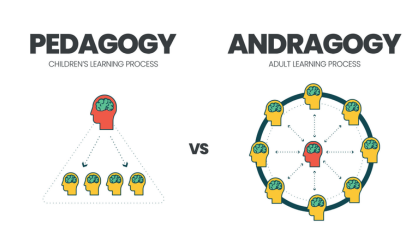In today's fast-paced and technology-driven world, learning has become more accessible than ever.
One such innovative learning approach is multimodal learning, which integrates various sensory inputs to enhance the learning experience.
This method leverages a combination of different learning styles such as visual, auditory, kinesthetic, and more to engage learners.
In this article, we will delve into what multimodal learning is and how it can benefit learners in their personal and professional growth.
What Is Multimodal Learning?

Multimodal learning is an approach to learning that integrates multiple sensory inputs to create a more engaging and effective learning experience.
This method of learning leverages different learning styles, including visual, auditory, kinesthetic, and more, to provide learners with a diverse range of stimuli.
The goal of multimodal learning is to cater to different learning preferences, which helps learners better retain information and apply it in real-life situations.
According to an analysis, a significant majority of students (72.6%) expressed their inclination toward learning through various sensory modalities.
By combining different modalities, learners can engage with the material in various ways, leading to a more comprehensive understanding and improved learning outcomes.
The VARK framework
The VARK framework is a widely-used approach to understanding and categorizing learning preferences.
Developed by Neil Fleming in 1987, the VARK framework classifies learners into four modalities: visual, auditory, reading/writing, and kinesthetic.
By understanding these modalities, learners can gain insight into their preferred learning styles and use them to their advantage to improve their learning experience.
1. Visual Learners
Visual learners prefer to learn through visual aids, such as diagrams, charts, graphs, and videos.
These learners often have strong spatial skills and are good at remembering images and colors. Visual learners may benefit from mind maps, concept maps, and other graphical representations that help them visualize information.
They may also prefer to read materials that are well-formatted with plenty of headings, subheadings, and bullet points.
2. Auditory Learners
Auditory learners prefer to learn through sound and spoken words.
These learners often have strong listening skills and can remember information they have heard more easily than information they have read.
Auditory learners may prefer to attend lectures, participate in discussions, and listen to audio recordings.
They may also benefit from using mnemonic devices and repeating information aloud.
3. Reading/Writing Learners
Reading/writing learners prefer to learn through written words.
These learners often have strong reading and writing skills and can remember information they have read more easily than information they have heard.
Reading/writing learners may prefer to read textbooks, take notes, and write summaries. They may also benefit from using flashcards and highlighting important information.
4. Kinesthetic Learners
Kinesthetic learners prefer hands-on learning and learn best through physical experiences.
These learners often have strong spatial and motor skills and may benefit from activities such as simulations, labs, and role-playing exercises.
Kinesthetic learners may also prefer to take frequent breaks to move around and may use physical gestures and body language to remember information.
Benefits Of The Multimodal Approach

The benefits of a multimodal approach to learning are numerous and far-reaching.
Here are some of the key advantages:
1. Improved Retention
One of the most significant benefits is that it can improve retention.
When learners engage with information in multiple ways, it becomes more memorable and easier to recall later on.
For example, someone who hears information and sees it presented visually is more likely to remember it than someone who only hears it.
Retaining information is crucial when it comes to learning, and e-learning has been found to be effective in this regard. Studies indicate that e-learning can result in a retention rate increase of 25% to 60%.
2. Increased Engagement
It can also increase engagement, as it allows learners to interact with information in ways that resonate with their individual learning styles.
This makes the learning experience more enjoyable and meaningful, which can lead to better learning outcomes.
3. Accommodation Of Different Learning Styles
As mentioned, everyone has a preferred learning style.
A multimodal approach can accommodate these differences by presenting information in different formats.
For example, someone who learns best through visual means can benefit from videos or infographics, while someone who learns best through auditory means can benefit from lectures or podcasts.
4. Flexibility
Another advantage of is its flexibility.
Learners can engage with information in a way that suits their needs and preferences.
For example, someone who is a visual learner can review an infographic multiple times, while someone who is an auditory learner can listen to a podcast while commuting.
5. Improved Problem-Solving Skills
When learners engage with information in multiple ways, they are also more likely to develop a broader range of problem-solving skills.
This is because they are exposed to different ways of thinking and approaching problems, which can help them become more versatile and adaptable.
6. Real-World Relevance
It can also make learning more relevant to the real world.
By presenting information in a variety of formats, learners can see how it applies to different contexts and situations, which can help them connect the dots and apply their knowledge in practical ways.
Overall, the benefits of a multimodal approach to learning are clear.
By engaging with information in multiple ways, learners can improve their retention, increase engagement, accommodate different learning styles, and develop a broader range of problem-solving skills.
Additionally, the flexibility and real-world relevance of this approach makes it an excellent choice for modern learners.
Best Multimodal Learning Examples

Here are some effective multimodal learning examples:
1. Interactive E-Learning Modules
E-learning modules that combine text, graphics, videos, and interactive elements such as quizzes, games, and simulations are effective in engaging learners and promoting active learning.
2. Flipped Classroom
In a flipped classroom model, learners study course materials outside the classroom, such as through videos or podcasts, and then participate in interactive activities, discussions, and problem-solving exercises in the classroom.
3. Collaborative Learning
Group projects, peer-to-peer discussions, and team-based learning activities provide opportunities for learners to work together, exchange ideas, and receive feedback, promoting deeper learning and knowledge retention.
4. Visual Aids And Graphic Organizers
Visual aids such as diagrams, flowcharts, and mind maps can help learners visualize complex information, understand relationships between concepts, and recall information more easily.
5. Hands-On Learning
Hands-on learning activities such as labs, simulations, and field trips allow learners to apply theoretical knowledge to real-world scenarios, promoting problem-solving skills and critical thinking.
6. Game-Based Learning
Gamification of learning content can increase motivation and engagement, while also promoting problem-solving skills, teamwork, and healthy competition.
By combining these multimodal learning examples, educators and trainers can create a more dynamic and engaging learning experience that appeals to a wide range of learners and promotes deeper understanding and knowledge retention.
Transform Your Employee Learning With Oreed
Did you know that 40% of Fortune 500 companies utilize e-learning tools?
Upgrade your employee learning process with Oreed, a comprehensive education intelligence platform that provides a holistic view of your workforce, empowering you to make informed decisions.
1. Revamp Your Training And Course Development
Oreed enables you to gain deep insights into your employees' learning needs, helping you design and develop customized training and courses for optimal results.
2. Track The Impact Of Your Training And Courses
Oreed also offers tools to measure and evaluate the effectiveness of your training and courses, ensuring your organization achieves desired outcomes.
3. Boost Your Business ROI With Oreed
Experience the Oreed difference and achieve a 10x increase in customer revenue and engagement with our comprehensive training platform.
In addition to boosting your revenue, we can help increase employee productivity and streamline your organizational processes, ensuring you get the most out of your investment.
Make the smart choice for your business and choose Oreed for the best possible ROI.
With our platform, you'll see significant improvements in customer engagement, employee productivity, and overall organizational efficiency.
So what are you waiting for? Book a demo with Oreed today and find out more about our features.
Promote lifelong learning through Oreed by experiencing the most powerful all-in-one training and development intelligent platform that streamlines all your organization's learning, training, and development activities in one place.
Final Thoughts
In conclusion, multimodal learning is an effective approach to education that combines multiple learning styles and media.
By incorporating different modes of learning such as visual, auditory, and kinesthetic, it caters to a wider range of learners and enhances knowledge retention.
Additionally, it can improve employee training and development, as well as benefit organizations by increasing productivity and efficiency.
With the advancements in technology, multimodal learning has become more accessible than ever before, making it an ideal option for individuals and organizations looking to upgrade their learning and development processes.
FAQs
1. What is a multimodal learner?
A multimodal learner is someone who benefits from learning through multiple sensory channels such as visual, auditory, and kinesthetic.
2. What are the benefits of being a multimodal learner?
Multimodal learners can process and retain information more effectively, leading to better performance in learning tasks.
They can also use a variety of strategies to learn and remember information.
3. What are the benefits of multimodal response approaches?
Multimodal response approaches offer a range of benefits for learners.
First and foremost, these approaches cater to different learning styles and preferences, making it more likely that each individual will find a mode of response that resonates with them.
Additionally, by providing multiple ways of engaging with the material, multimodal response approaches can help deepen understanding and facilitate knowledge retention.
They can also promote creativity and self-expression, allowing learners to demonstrate their understanding in unique and meaningful ways.
Finally, by offering a variety of response options, multimodal approaches can help learners develop a diverse set of skills, such as critical thinking, communication, and digital literacy.
Overall, the benefits of multimodal response approaches make them a valuable tool for enhancing learning outcomes.





